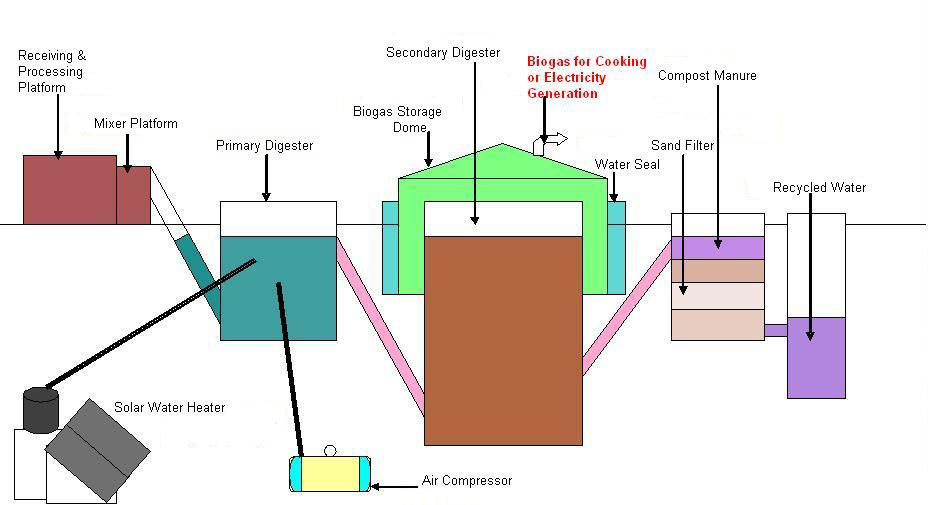Advantages of Biogas Plant:
- Installation of our biogas plant will enable you to very conveniently treat your entire biodegradable waste and thereby maintain a clean, hygienic, pollution free environment and also avoid all hassles of storage and transportation of waste.
- Hygienic surrounding and airtight top covers for the system, hence no smell and foul odour from this system.
- No flies and mosquitoes problem, birds and stray dogs, cattle menace and also no rats and rodents problem.
- Electricity requirement is very low.
- Water consumption is very low.
- Saving in terms of transport and labour costs for disposal of above waste from source of generation to the disposal site.
- Biogas, a renewable source of non-conventional energy generated, is proportional to the waste loaded per day.
- Maintenance cost is low since the operation of the equipment is periodic.
- We also undertake annual operation and maintenance contract or only preventive maintenance contract on separate mutually agreed terms and conditions.
- The biogas produced provides smoke free fuel to your kitchen, can be used to fire boilers or for electricity generation.
- The government has allowed 100% depreciation in the year of installation for this non-conventional source of energy and environmentally friendly waste disposal system.
- The high quality manure generated, which would be weed less can be used directly in your garden as it has excellent organically rich fertilizer properties and no foul smell.
- The size of our plant is very compact, can be installed in the area close to the generation of waste.
The Principle:
Biomass in any form is ideal for the Biomethanation concept, which is the central idea of the Nisargruna Biogas plants. BARC Mumbai based on thermophilic microorganisms and microbial processes develop the design of the biogas plant. The plant is completely gravity based.
Brief process description:
The segregated wet garbage (food waste) is brought to the plant site in bins and containers. It is loaded on a sorting platform and residual plastic, metal; glass and other non-biodegradable items are further segregated. The waste is loaded into a Waste Crusher along with water, which is mounted on the platform. The food waste slurry mixed with hot water is directly charged into the Primary digester.
This digester serves mainly as hydrolysis cum acidification tank for the treatment of suspended solids. For breaking slag compressed air is used for agitation of slurry. Compressed air will also help in increasing aeration since bacteria involved in this tank are aerobic in nature. The tank is designed in such a way that after the system reaches equilibrium in initial 4-5 days, the fresh slurry entering the tank will displace equal amount of digested matter from top into the main digester tank.
Main digester tank serves as a methane fermentation tank and BOD reduction takes place here. The treated overflow from this digester is connected to the manure pits. This manure can be supplied to farmers at the rate of Rs.4-5 per Kg. Alternatively municipal gardens and local gardens can be assured of regular manure from this biogas plant.
The biogas is collected in a dome (Gas holder) is a drum like structure, fabricated either of mild steel sheets or fibreglass reinforced plastic (FRP). It fits like a cap on the mouth of digester where it is submerged in the water and rests in the ledge, constructed inside the digester for this purpose. The drum collects gas, which is produced from the slurry inside the digester as it gets decomposed and rises upward, being lighter than air. Biogas burners will be provided. The biogas can be used for cooking, heating and power generation purpose.
Suitable locations for installation of plant:
Hotel premises, army/big establishment canteens (private/ government), residential schools/colleges, housing colonies, religious places / temple trusts, hospitals, hotels, sewage treatment plants, villages, etc.
Technical Details of Biogas Plant
| Capacity (Tons/ Day) | Methane Generation M3 | Manure production (Kg /day) | Area Required M2 | Cooking Fuel (Equivalent to LPG Cyl / day) or Electricity Generation |
|---|---|---|---|---|
| 1 | 60 | 100 | 300 | 2-3 (5KVA) |
| 2 | 120 | 200 | 400 | 4-5 (10KVA) |
| 3 | 180 | 300 | 400 | 4-5 (10KVA) |
| 4 | 240 | 400 | 500 | 8-10 (20KVA) |
| 5 | 300 | 500 | 500 | 12-14 (25KVA) |
| 10 | 600 | 1000 | 800 | 22-25 (50KVA) |
Biogas Plants by VIVAM Solid Waste Management Pvt. Ltd.
| Location | Type of Waste | Capacity | Date of Commencement | Utility of Gas |
|---|---|---|---|---|
| Chandrapur Municipal Council | Vegitable Market Waste | 1.5 TPD | December 2006 | Kitchen |
| Nanded Municipal Corporation | Banana Market Wasye | 1.5 TPD | February 2008 | Electricity(Proposed) |
| CARD Trust, Anjangaon Surji, Dist. Amravati | Farm Waste | 1 TPD | March 2008 | Electricity |
| Parivartan Trust, Chipalun, Dist. Ratnagiri | Farm Waste | 1 TPD | March 2008 | Electricity |
| Kagal Municipal Council | MSW | 3 TPD | Octomber 2008 | Electricity (Proposed) |
| Pandharpur Municipal Council | MSW | 6 TPD | November 2008 | Electricity |
| Pune Municipal Corporation | MSW | 5 TPD | November 2009 | Electricity |
| Beed Municipal Council | MSW | 5 TPD | December 2010 | Electricity(Proposed) |
| Amalner Municipal Council | MSW | 5 TPD | December 2010 | Electricity(Proposed) |
| Sihagad Education Institute, Pune | Kitchen Waste | 0.5 TPD | December 2010 | Cooking |
| Wardha Municipal Council | MSW | 1.5 TPD | January 2011 | Electricity |
| Ramtek Municipal Council | MSW | 2 TPD | Febuary 2011 | Electricity |
| Padegaon Slaughter House, Aurangabad Corporation | Slaughter House Waste | 3 TPD | December 2011 | Electricity |

